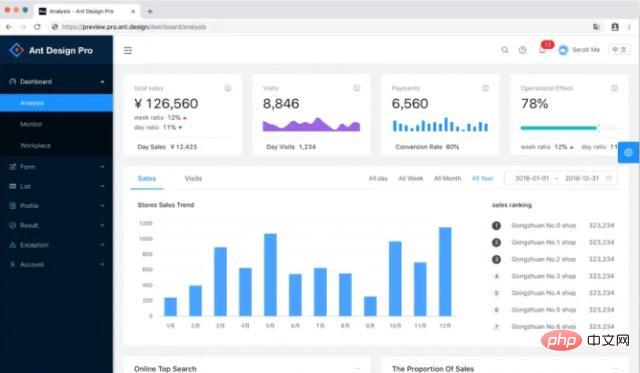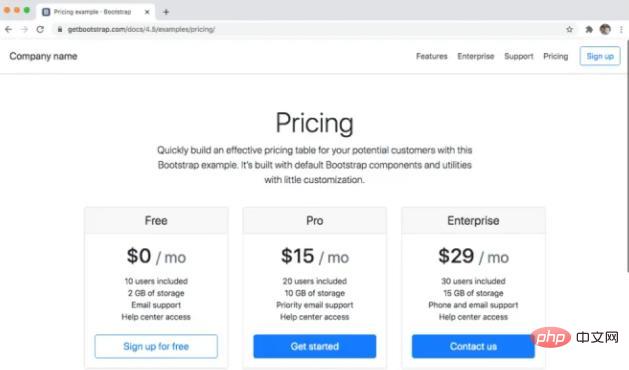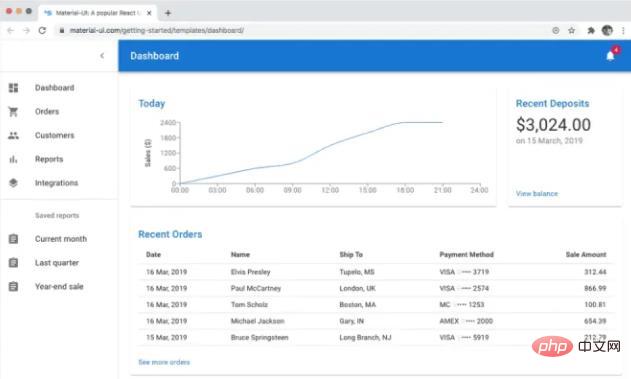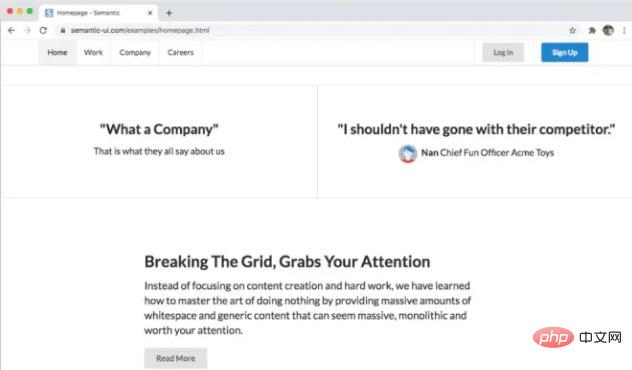The react components are: 1. Ant Design; 2. Bootstrap; 3. Bulma; 4. Chakra UI; 5. Material UI; 6. Semantic UI; 7. Reach UI; 8. Reakit; 9. Rebass wait.

The operating environment of this tutorial: Windows 10 system, react18.0.0 version, Dell G3 computer.
What are the components of react?
Top React component library recommendation
Ant Design

Project link:
- Ant Design
- Bundle size (from BundlePhobia): 1.2mB after minification, 349.2kB after gzip compression, reduce the size by tree shaking.
Pros:
- AntDesign comes with extensive supporting documentation, has a community, and includes a separate project (AntDesignPro) with pre-made templates;
- UI library that can be used to quickly design backend/internal applications.
Disadvantages:
- Lack of accessibility;
- Large size, expected to have a large impact on performance;
- Pollute your CSS (expect to add !important to prevent it from styling your non-Ant components).
Bootstrap

- React Bootstrap
-
- ##https://react-bootstrap.github .io/ Bundle size (from BundlePhobia): 111kB minified, gzip compressed 34.4kB, shaken Tree reduction volume
- Reactstrap
-
- https://reactstrap.github.io/ Bundle size (from BundlePhobia): 152.1kB after minification, 39.4kB after gzip compression, reduce the size by tree shaking
- Advantages:
- Easily customizable via CSS-in-JS;
- It’s been around long enough , so no need to worry about bugs/issues;
- Get started quickly;
- No jQuery dependencies as it has been completely re-implemented in React.
- shortcoming:
- This is Bootstrap: if you don’t customize it, your site will look like any other.
Bulma

Bulma is different from other libraries introduced in this article because Bulma is pure CSS Framework, no JS required. You can choose to use classes from Bulma directly or use a wrapper library such as react-bulma-components.
Project link:
- Bulma
- react-bulma-components
- Bundle size (from BundlePhobia): 179kB minified, minified gzip Compressed 20.1kB
Advantages:
- Won’t make your website look like Bootstrap;
- Suitable for quick startup and operation;
- Modern features (underlying is Flexbox/Grid).
Disadvantages:
- Accessibility: There are some, but they don’t follow WCAG guidelines as strictly as other libraries.
Chakra UI

Project link:
- ChakraUI
- Bundle size (from BundlePhobia): 326.2kB minified, 101.2kB gzipped, reduced by tree shaking
Pros:
- Accessibility: Following WAI-ARIA guidelines, components use aria tags;
- Powered by Discord server;
- Easily customizable (with theme support);
- Highly modular, so tree shaking will actually remove code you don't use.
Disadvantages:
- Quite new.
NOTE:
It is very close to the v1 version, so please be aware of breaking changes after v0.8.0.
Material UI

MaterialUI is one of those libraries that I have a love-hate relationship with. It's helped me get through some very stressful project deadlines in the past, but in the end I always got it out of the way as quickly as possible.
In the past, you could only customize MaterialUI's styles by writing JSS, but thankfully you can now override styles using styled-components and Emotion.
https://material-ui.com/guides/interoperability/#styled-components
Project link:
- Material UI
- Bundle size (from BundlePhobia): 325.7kB after minification, reduced gizp compression 92kB, reduced size by tree shaking
Advantages:
- Complete documentation
- The icon library is very large
- Simple and easy to use (at the beginning)
Disadvantages:
- Difficult and painful to customize, but necessary (to improve visual effects);
- Performance: Too many DOM nodes will be rendered;
- Your app will look like a Google product (for some, this may represent a professional look).
Semantic UI

- Semantic UI
- Semantic-UI-React
- Bundle size (from BundlePhobia): 300.8kB after minification, 80.9kB after gzip compression, reduce the size by tree shaking.
- Combinable (use as prop to pass components)
- Easy to customize
- Easy to use documentation
- Well-known by users (used internally by Netflix and used by products released by Amazon)
- TypeScript support
- Potential disadvantages of open source projects Certainty.
-
- View issue:
- https://github.com/Semantic-Org/Semantic- UI/issues/6109
- ##https://github.com/Semantic-Org/Semantic-UI/issues/6413 Community-run fork:
- ##https://
-
github.com/fomantic/Fomantic-UI
##Honorable Mention
ReachUI is a low-level component library that allows developers to build accessible React components into their design systems. There is no package size available because each component is exported individually as its own npm package.
ReakitReakit is another low-level component library. Technically it's a UI library, but it doesn't come with CSS. So you still need to find a styling solution.
Bundle size (from BundlePhobia): 119.9kB minified, 32.1kB gzip compressed, reduced by tree shaking.- Rebass

I have been following Rebass for a while. It is a powerful component library that does not come with a theme, but you can easily change the theme. For a practical example of it, see its demo:
Project link:
- Rebass
- Bundle size (from BundlePhobia): 43kB after minification, gizp compression 14.4kB, reduce the size by tree shaking.
Tip
When writing this list, I tried to avoid including commercial design systems, but some systems (Material UI) have become widely adopted, so they are not included The list would not be complete.
I also intentionally omitted CSS-in-JS (such as styled-components and Emotion) and utility CSS systems (such as Tailwind, https://tailwindcss .com/), because they are not explicitly "React component libraries" but rather tools for making components.
Recommended learning: "react video tutorial"
The above is the detailed content of What components does react have?. For more information, please follow other related articles on the PHP Chinese website!

Hot AI Tools

Undress AI Tool
Undress images for free

Undresser.AI Undress
AI-powered app for creating realistic nude photos

AI Clothes Remover
Online AI tool for removing clothes from photos.

Clothoff.io
AI clothes remover

Video Face Swap
Swap faces in any video effortlessly with our completely free AI face swap tool!

Hot Article

Hot Tools

Notepad++7.3.1
Easy-to-use and free code editor

SublimeText3 Chinese version
Chinese version, very easy to use

Zend Studio 13.0.1
Powerful PHP integrated development environment

Dreamweaver CS6
Visual web development tools

SublimeText3 Mac version
God-level code editing software (SublimeText3)
 React vs. Vue: Which Framework Does Netflix Use?
Apr 14, 2025 am 12:19 AM
React vs. Vue: Which Framework Does Netflix Use?
Apr 14, 2025 am 12:19 AM
Netflixusesacustomframeworkcalled"Gibbon"builtonReact,notReactorVuedirectly.1)TeamExperience:Choosebasedonfamiliarity.2)ProjectComplexity:Vueforsimplerprojects,Reactforcomplexones.3)CustomizationNeeds:Reactoffersmoreflexibility.4)Ecosystema
 React's Ecosystem: Libraries, Tools, and Best Practices
Apr 18, 2025 am 12:23 AM
React's Ecosystem: Libraries, Tools, and Best Practices
Apr 18, 2025 am 12:23 AM
The React ecosystem includes state management libraries (such as Redux), routing libraries (such as ReactRouter), UI component libraries (such as Material-UI), testing tools (such as Jest), and building tools (such as Webpack). These tools work together to help developers develop and maintain applications efficiently, improve code quality and development efficiency.
 Netflix's Frontend: Examples and Applications of React (or Vue)
Apr 16, 2025 am 12:08 AM
Netflix's Frontend: Examples and Applications of React (or Vue)
Apr 16, 2025 am 12:08 AM
Netflix uses React as its front-end framework. 1) React's componentized development model and strong ecosystem are the main reasons why Netflix chose it. 2) Through componentization, Netflix splits complex interfaces into manageable chunks such as video players, recommendation lists and user comments. 3) React's virtual DOM and component life cycle optimizes rendering efficiency and user interaction management.
 React: The Power of a JavaScript Library for Web Development
Apr 18, 2025 am 12:25 AM
React: The Power of a JavaScript Library for Web Development
Apr 18, 2025 am 12:25 AM
React is a JavaScript library developed by Meta for building user interfaces, with its core being component development and virtual DOM technology. 1. Component and state management: React manages state through components (functions or classes) and Hooks (such as useState), improving code reusability and maintenance. 2. Virtual DOM and performance optimization: Through virtual DOM, React efficiently updates the real DOM to improve performance. 3. Life cycle and Hooks: Hooks (such as useEffect) allow function components to manage life cycles and perform side-effect operations. 4. Usage example: From basic HelloWorld components to advanced global state management (useContext and
 The Future of React: Trends and Innovations in Web Development
Apr 19, 2025 am 12:22 AM
The Future of React: Trends and Innovations in Web Development
Apr 19, 2025 am 12:22 AM
React's future will focus on the ultimate in component development, performance optimization and deep integration with other technology stacks. 1) React will further simplify the creation and management of components and promote the ultimate in component development. 2) Performance optimization will become the focus, especially in large applications. 3) React will be deeply integrated with technologies such as GraphQL and TypeScript to improve the development experience.
 Frontend Development with React: Advantages and Techniques
Apr 17, 2025 am 12:25 AM
Frontend Development with React: Advantages and Techniques
Apr 17, 2025 am 12:25 AM
The advantages of React are its flexibility and efficiency, which are reflected in: 1) Component-based design improves code reusability; 2) Virtual DOM technology optimizes performance, especially when handling large amounts of data updates; 3) The rich ecosystem provides a large number of third-party libraries and tools. By understanding how React works and uses examples, you can master its core concepts and best practices to build an efficient, maintainable user interface.
 React, Vue, and the Future of Netflix's Frontend
Apr 12, 2025 am 12:12 AM
React, Vue, and the Future of Netflix's Frontend
Apr 12, 2025 am 12:12 AM
Netflix mainly uses React as the front-end framework, supplemented by Vue for specific functions. 1) React's componentization and virtual DOM improve the performance and development efficiency of Netflix applications. 2) Vue is used in Netflix's internal tools and small projects, and its flexibility and ease of use are key.
 React vs. Backend Frameworks: A Comparison
Apr 13, 2025 am 12:06 AM
React vs. Backend Frameworks: A Comparison
Apr 13, 2025 am 12:06 AM
React is a front-end framework for building user interfaces; a back-end framework is used to build server-side applications. React provides componentized and efficient UI updates, and the backend framework provides a complete backend service solution. When choosing a technology stack, project requirements, team skills, and scalability should be considered.






